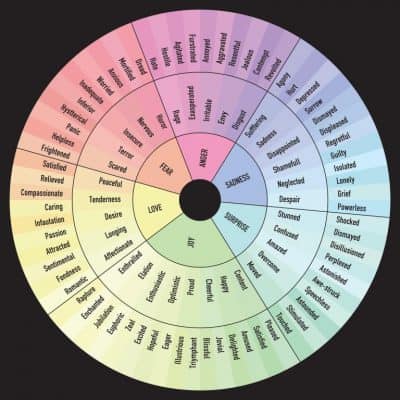
Very often as children we are taught a very basic set of emotions. ‘Happy’, ‘sad’ or ‘angry’. In the early years this serves us well and pretty much covers all of the bases. But, as we get older and life gets busier, more stressful and complicated, we don’t always have the vocabulary or understanding to explain our depth of feelings in detail. This in turn can prevent us knowing how to help ourselves, particularly in the mental health area.
Wheel of Emotions or Feelings
There is a graphical tool that you might find helpful, colloquially it is known as a ‘Wheel of Emotions’. You can see one version depicted in the photograph with this article. But if you search online, you can find printable versions to download.
The Geneva Emotion Wheel has a circle shape, which is split into four quadrants. These are ranked pleasant-unpleasant, controllable-uncontrollable.
The next option was designed and named after psychologist Robert Plutchik. It starts with eight emotions in the middle and this spreads out in terms of intensity and relationship between the emotions.
The last option is the Junto Wheel, this is possibly the easiest to use. At the centre are all the emotions that we recognise from sadness, fear to joy etc. Then as it spreads to the outer edge of the circle it delves into each feeling in more detail, attaching more words to each sentiment.
Why would you use the wheel?
If you have a general feeling of being blocked and don’t know exactly how to move forward. Or you don’t exactly feel fulfilled, but can’t put your finger on why. Then the wheel can help you to explore and dig a little deeper into your underlying feelings.
You may also use the wheel for a specific problem. For example, if you are struggling with goals, like diet, reducing alcohol, exercising more etc. Then you may be using these crutches to cope with your emotions. If you explore what these feelings are and why you feel driven to bury these emotions rather than face them, you are less likely to turn to unhealthy means to deal with them.
If you are just struggling at the moment, you can use the wheel as a whole or drill down to a particular category. Hopefully looking at the wheel will remind you that not all feelings and emotions are negative. It can quickly put you back on track to realising how much you have to look forward to and be thankful for.
Posted: 15/10/2021
Related Category: Health













